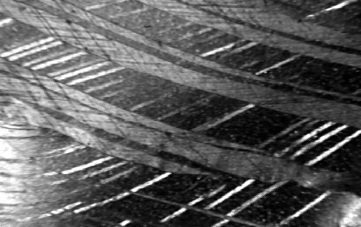 CET/UWA Microstructure Course
CET/UWA Microstructure Course CET/UWA Microstructure Course
CET/UWA Microstructure Coursewavy extinction, common in quartz and calcite, due to plastic strain. The crystal lattice is actually bent, so that when the microscope stage is rotated, one or more bands of extinction with gradational boundaries will sweep across the grain. Shows that the crystal is full of a distributed cloud dislocations. Common in quartz calcite.

single orientation of extinction across whole grain, implies low density of dislocations
distinct bands of different extinction that are obviously part of the same crystal. a more localised form of undulose extinction where some concentration of dislocation has taken place. In picture below they trend NE-SW

sharp sided, narrow and repeating bands usually forming sub-parallel to a specific crystallographic orientation, such as the basal plane in quartz. can be due to a number of processes, but are commonly zones of concentrated slip on a given slip system. In picture below they trend NE-SW

small regions within a grain with uniform extinction, but clearly related to other subgrains in orientation, which together make up a whole grain. The misorientation sufficient to declare that two regions are still subgrains is to say that the misorientation is less than 7 degrees, but this is impossible to measure using a standard microscope and stage. Forms by migration and accumulation of dislocations with the same sign. Often concentrated at grain edges at low temperatures.

imperfections in a crystal lattice. include point, line and plane defects. Abundant in all natural crystals.
parallel sided zone of differently oriented crystal within a single grain, with special "twin orientation" between zone and host crystal. The amount of strain undergone during the passage of a twin boundary is fixed, and no further twin related strain takes place once a twin has passed a particular point. Very common in deformed calcite and plagioclase.

Copyright Mark Jessell & Paul Bons 2000